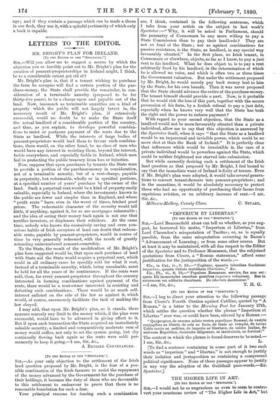TH1 HIGHER LIFE IN ART.
[To THE EDITOR O' THE "SPECTATOR.'} SIR,—I would not be so ungracious as even to seem to contro- vert your courteous review of "The Higher Life in Art," but there is one passage that has been so wrenched from its true meaning by being quoted without its context, that I feel sure you will do me the justice of inserting these few lines. My claim for Art is exactly the reverse of that which you have attributed to me. It is that while religion can do without science, and science without religion, Art cannot do without
tither, but draws her strength from both. My words are these :—
" For it is impossible to live the Higher Life in Art without being led from one glory to another. Art stands alone in this, that it engages not some, but every faculty of our being. Faith, reason, affection are alike exercised in its mission. Theologians might dis- pute for ever without the aid of the geometrician, but without his cobweb of fine lines Art could not have built the temples, the firma- ments of stone, beneath which they worship. Mathematicians might still be analysing triangles and spheres if Christ had not died ; but without the hope of life of which He came to assure us, Art would have built no temples at all. Like the summer clouds which fill the sky, Art sweeps across our world, drawing into its bosom all our religious aspirations, all our scientific attainments, every tender emotion of our hearts. How beautiful are these summer clouds ! now ranged in lines like the battlemented walls of a distant city ; now massed together like an army with banners ; now drifting through the azure in a myriad of ethereal shapes, like a company of angels looking down on us from heaven. How beautiful is Art ! in the splendour of its imagery ; in its storms of passion ; in its serene contemplation of things divine. But they are only clouds ! But it is only Art ! And yet, Thou sentest a gracious rain upon Thine inheritance, and refreshedst it when it was weary.' So, then, the clouds are of some account. And Art ? No tender thought, or noble aspiration, or high enterprise is lost to us, because Art fashions them into beautiful shapes. They come back to la, as the rain comes from the clouds, and they make our lives fruitful in faith and wisdom and love. For the artist lives, and works, and dies ; but Art, in its Higher Life, is immortal." (pp. 18627.)
As this paragraph is really the summary of my whole argu- ment, it would be especially distressing to me for its purport to
be absolutely reversed.—I am, Sir, &c., WYKE BAYLISS.



































 Previous page
Previous page